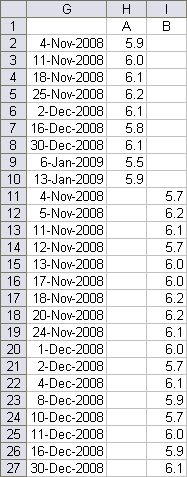Deacsfan27
Well-known member
I feel like this is the kind of question you should have farmed out to a smaller group of people before you posted it in a very public forum.
Definitely.
I feel like this is the kind of question you should have farmed out to a smaller group of people before you posted it in a very public forum.
oh, doofus
Kinda guy who rips on Diggler for being religious, but can't do middle school math. Fucking Doofus.
Alright folks. Need some help (this is probably pretty simple but I am awful at Excel).
I have a column that has a lot of monthly premiums in it. This column is not tied to another column, but is the sum of a base premium and a tax, so just one number. We do not have the separation of these two because we are taking over an account from a different company, and just have to equal the total amount in each cell. We have to break it down for tax purposes though, so we need a base premium, and the taxes that you add to it to get the number in the cell.
The total in this each cell of the column is X + 2% = Column A Cell. I need to find what "X" is though.
For example:
The first cell is $109.29. What I need to find is the number that, when 2% is added to it equals $109.29.
By trial and error I can clearly get to the number eventually (it's $107.14 or $107.15), but there are 500+ numbers I have to figure out, so I'm not going to manually do it.
Ex: 107.14 + 2% = $109.28282828
107.15 + 2% = $109.293
Please help, and I can explain more clearly if need be.
Jesus Christ
| Date 1 | Date 2 |
| 7/1/17 | |
| 7/15/17 | 8/5/17 |
| 7/18/17 | |
| 7/21/17 | |
| 7/30/17 | |
| 8/4/17 | |
| 8/7/17 | |
| 8/8/17 | |
| 8/9/17 | |
| 8/10/17 | |
| 8/11/17 | 8/13/17 |
| 8/12/17 | 8/14/17 |
| 8/13/17 | |
| 8/14/17 | |
| 8/15/17 | 8/15/17 |
Thanks, doing so I was able to get it to plot on the line graph. I've got a new issue though. Date 1 and Date 2 are plotted as two different lines, with a series of dates being my X-axis. Using a line chart, I only have one option for my x axis, which I used my largest column (Date 1). As a result, the cumulative totals are correct, but its attributing the total for Date 2 to the date associated with Date 1.

Pivot!
Need some help
The goal is to determine the Year 1 payment for something where you know the annual percentage increase in payment and the total paid over n years. For example:
- 60 year term
- $10 million in total payments
- Assume 3% annual inflation in payment
Given that information, what formula will get me my Year 1 payment such that I can change my assumptions. I know it involves some summation calculation, but I can't figure it out.
